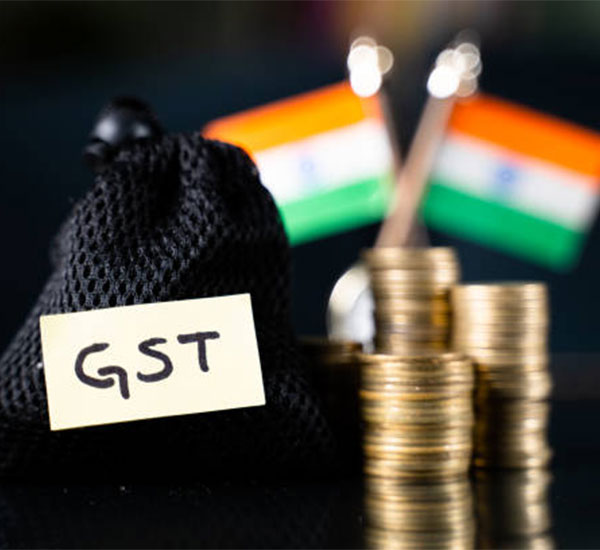
What We Offer
Key Features For Our GST Filing
Businesses that have registered for GST are required to submit GST returns on a monthly, quarterly,
or annual basis, depending on their particular industry. Here, information on the sales or purchases
of goods and services is required, as well as information about the tax that was collected and paid.
GST, a comprehensive income tax system, has been implemented in India, guaranteeing that taxpayer
services including registration, returns, and compliance are within budget and precisely
coordinated.
Four forms, including returns for supplies, returns for purchases, monthly returns, and yearly
returns, must be submitted by an individual taxpayer who is completing GST returns.
Advantages of GST Filing are:
Table Of Contents
Know Everything About GST Filling

Company Registration Process
GST Filing Process
The GST filing process involves submitting GST returns to the government to report your sales, purchases, and tax liabilities. Every GST-registered business must file returns either monthly, quarterly, or annually, depending on their turnover and type of registration. The most common forms include GSTR-1 (for outward supplies), GSTR-3B (for monthly summary), and GSTR-9 (for annual return). To file returns, businesses must log in to the GST portal, enter invoice-level details, claim Input Tax Credit, and pay any tax dues. Timely filing helps avoid penalties and ensures a smooth flow of credits. Errors in GST return filing can lead to notices and blocked credits. Therefore, using professional help like Madaliya.com ensures accurate, timely, and compliant GST filing.
GST Filing Online
Filing GST online has made tax compliance more accessible and efficient for Indian businesses. You no longer need to visit a tax office or depend solely on accountants for filing returns. Instead, by logging in to the official GST portal (www.gst.gov.in), businesses can file returns, pay taxes, download return summaries, and track return status—all online. The portal supports multiple return forms and offers real-time status updates. Businesses can also use tools like offline utilities, reconciliation software, and auto-fill data to make the process smoother. However, to avoid costly mistakes and to keep up with the frequent rule changes, it’s smart to use expert support. Platforms like Madaliya.com offer reliable online GST filing services, ensuring your taxes are filed accurately and on time.
GST Filing Services
Professional GST filing services are essential for businesses that want to focus on growth while staying compliant with tax laws. These services include everything from monthly return filing, reconciliation of invoices, Input Tax Credit claims, to annual GST audits. Whether you are a startup, MSME, or large enterprise, expert filing services ensure that your GST returns are error-free, timely, and in line with the latest regulations. Missing deadlines or filing incorrect returns can attract penalties, audits, and loss of credit. By outsourcing to specialists like Madaliya.com, you get access to GST experts who manage all compliance needs, respond to GST notices, and even help you with record-keeping. With customized packages and end-to-end support, Madaliya’s GST services are ideal for hassle-free tax management.
Eligibility Criteria
Who should file the GST returns?
GST Return filing in India is to be done by the following:
- A person having a valid GSTIN has to compulsorily file the GST returns.
- Also, a person whose annual turnover is crossing Rs. 20 lakh has to obtain a GST registration and file the GST returns mandatorily.
- In the cases of Special states, the limit for the annual turnover is Rs.10 lakh.
Types of GST Registration
What are the different types of GST registration in India?
| GSTR 1 | Details of the outward supplies of the taxable goods and or services | Monthly |
| Quarterly (If opted under the QRMP scheme) |
| GSTR 3B | Simple returns in which a summary of the outward supplies along with the input tax credit that is declared and the payment of the tax is affected by the taxpayer. | Monthly |
| Quarterly |
| CMP 08 | Statement cum challan to make a tax payment by a taxpayer registered under the composition scheme under Section 10 of the CGST Act. | Quarterly |
| GSTR 4 | Returns to be filed by the taxpayer that is registered under the composition scheme under Section 10 of the CGST Act | Annually |
| GSTR 5 | Returns to be filed by a Non-resident taxable person | Monthly |
| GSTR 6 | To be filed by the input service distributor to distribute the eligible input tax credit | Monthly |
| GSTR 7 | Is filed by the government authorities | Monthly |
| GSTR 8 | Details of supplies that are affected through the e-commerce operators and the amount of tax that is collected at the source by them. | Monthly |
| GSTR 9 | Annual return for a normal taxpayer | Annually |
| GSTR 9C | Certified reconciliation statement | Annually |
| GSTR 10 | Is filed by the taxpayer whose GST registration is canceled | Once the GST registration is canceled or surrendered |
| GSTR 11 | Details of the inward supplies are furnished by a person who has UIN and also claims a refund. | Monthly |
Due dates for filing the GST returns
What are the due dates for filing GST returns?
GSTR 1: The 11th of Subsequent of that month
GSTR 3B: The 20th of that subsequent month
CMP 08: 18th of the month succeeding the quarter of the specific fiscal year.
GSTR 4: 18th of the month succeeding the quarter.
GSTR 5: 20th of the subsequent month
GSTR 6: 13th of the subsequent month
GSTR 7: 10th of the subsequent month
GSTR 8: 10th of the subsequent month
GSTR 9: 31st December of the Fiscal year.
GSTR 10: Within 3 months of the date of cancellation or the date of cancellation order whichever is earlier.
GSTR 11: 28th of the month that is following the month for which the statement was filed.
Who Should File GST Return
- Regular enterprises with an annual aggregate revenue of more than ₹5 crore
- Taxpayers who did not choose the QRMP plan are required to file two monthly returns and one yearly return under the GST system
- QRMP filers must submit nine GSTR files annually, which include four GSTR-1 and three GSTR-3B forms as well as an annual return. It should be noted that even if QRMP filers submit their returns on a quarterly basis, they must pay tax on a monthly basis
- Additionally, separate statements and returns must be filed in other circumstances, such as in the case of composition dealers, who must submit five GSTR files annually (4 statement-cum-challans in CMP-08 and 1 annual return GSTR-4).
Documents Required for GST Return Filing
- Invoices issued to persons with GSTIN or B2B invoices
- Invoices issued to persons without GSTIN or B2C invoices
- This needs to be submitted only when its total value is above ₹2.5 lakhs
- A consolidation of inter-state sales
- HSN-wise summary of all goods sold
- Any other debit or credit notes or advance receipts
GST Return Filing under the Composition Scheme
Taxpayers registered under the Composition Scheme must pay taxes using CMP-08 every quarter and file GSTR-4 annually through the GST Common Portal or a GST Facilitation Centre. The due date for the GST return for Composition Scheme registrants is the 18th of the month following each quarter, namely 18 April, 18 July, 18 October, and 18 January. The GST return must contain details of:
- Details of supplies received from registered and unregistered persons, both intra-state and inter-state, should be provided on an invoice-wise basis.
- The GST return filed by a Composition Scheme supplier must also contain a summary of the supplies they have made to their customers.
If a person registered under GST has chosen to pay taxes under the Composition Scheme from the start of a financial year, they must file monthly GST returns on the 10th, 15th, and 20th of each month, and keep filing monthly returns until the due date of furnishing the return for September of the next financial year or the annual return of the preceding financial year, whichever comes first. Therefore, even if a taxpayer opts for the Composition Scheme from April onwards, they must continue filing monthly GST returns until September.
Benefits of GST Return Filing
GST Eliminates Cascading Effect
Earlier there were many instances where tax on tax was paid for a single transaction. As GST did away with several other taxes like central excise duty, service tax, customs duty, and state-level value-added tax, you no longer are subjected to paying tax on tax. This saves you money.
Higher Threshold
The threshold for GST is aggregate turnover exceeding 40 lakhs for sale of goods and aggregate turnover exceeding 20 lakhs for sale of services. This means small businesses falling below this threshold limit are not subject to GST Filing.
Easier for Startups and E-commerce Businesses
The GST system has made it easier for startups and e-commerce companies to manage their taxes. E-commerce particularly suffered from different tax laws across different states which are now eradicated by GST.
More Organised System
Before the GST tax return filing system was disorganised. Now, all taxes are paid online and major hassles that were a part of tax filing have been eliminated in the process of introducing GST.

Find Your Answers About GST Filling
Fill The Form to Get Started
Fill The Form to Avail Our Services








